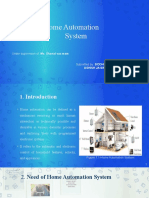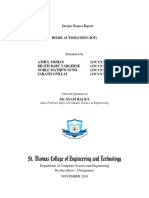0% found this document useful (0 votes)
123 views12 pagesIoT Smart Home Automation Thesis
This undergraduate thesis presents a smart home automation system based on IoT. It was developed by 4 students with equal contributions under the supervision of MD SIYAMUL ISLAM. The system aims to address the problems of high cost and lack of combined functionality in existing systems. It contains sections on problem definition, motivation, research questions, methodology, flow charts, block diagrams, results, synthesis, and future work. The findings show that the system can save money, energy, and prevent accidents while improving home security and lifestyle.
Uploaded by
N.Yathish rajCopyright
© © All Rights Reserved
We take content rights seriously. If you suspect this is your content, claim it here.
Available Formats
Download as PDF, TXT or read online on Scribd
0% found this document useful (0 votes)
123 views12 pagesIoT Smart Home Automation Thesis
This undergraduate thesis presents a smart home automation system based on IoT. It was developed by 4 students with equal contributions under the supervision of MD SIYAMUL ISLAM. The system aims to address the problems of high cost and lack of combined functionality in existing systems. It contains sections on problem definition, motivation, research questions, methodology, flow charts, block diagrams, results, synthesis, and future work. The findings show that the system can save money, energy, and prevent accidents while improving home security and lifestyle.
Uploaded by
N.Yathish rajCopyright
© © All Rights Reserved
We take content rights seriously. If you suspect this is your content, claim it here.
Available Formats
Download as PDF, TXT or read online on Scribd
/ 12






















































